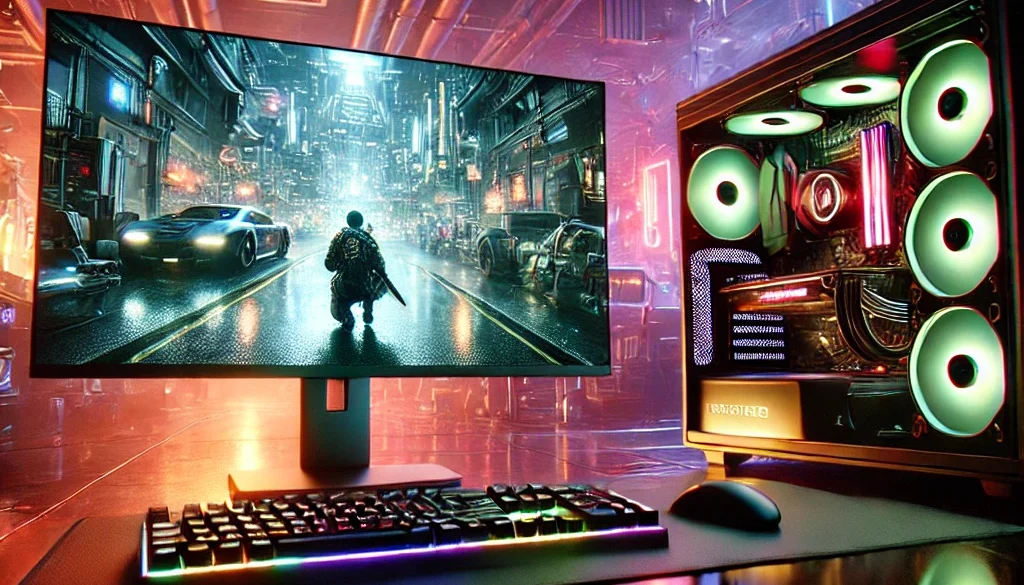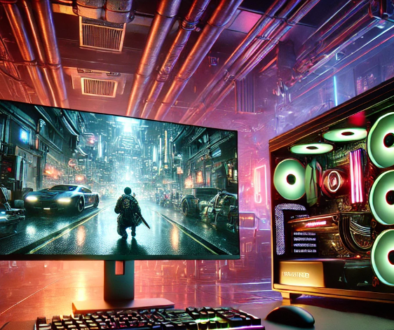How Many FPS is Good for Gaming? A Complete Guide
When you purchase through links on our website, we may earn an affiliate commission.

Ever felt like you’re watching a slideshow instead of playing a game? That’s the curse of low FPS! I remember the first time I experienced this – I was trying to play a new AAA title on my old laptop, and it was… well, let’s just say it was less than smooth. That’s when I realized how crucial FPS (Frames Per Second) is in gaming.
FPS is basically how many images your computer can show you per second while you’re playing. It’s like a digital flipbook – the more pages you can flip through, the smoother the animation looks. In this guide, we’ll dive deep into the world of FPS, figure out what’s good for different types of gaming, and help you find that sweet spot for your setup. Trust me, by the end of this, you’ll be an FPS pro!
Understanding FPS: The Basics
Alright, let’s break this down in simple terms. FPS, or Frames Per Second, is exactly what it sounds like – the number of frames (think: individual images) your computer can display each second when you’re gaming. It’s like a super-fast slideshow that creates the illusion of smooth motion.
I learned this the hard way when I first tried to play “Cyberpunk 2077” on my old PC. It was like watching a jerky robot dance! That’s when I realized how FPS affects gameplay. The higher your FPS, the smoother and more responsive your game feels. It’s not just about looks – it can impact how well you play, especially in fast-paced games.
But here’s the kicker – FPS isn’t just about your graphics card. Sure, that’s a big part, but it’s also affected by your CPU, your game settings, and even your monitor. It’s like a digital symphony – all the parts need to work together for that sweet, smooth gaming experience.
The FPS Spectrum: From Cinematic to Competitive
Let’s take a journey across the FPS landscape, shall we? It’s a wild ride, trust me! At the lower end, we’ve got 30 FPS. This is what most movies and TV shows run at, which is why it’s often called the “cinematic” frame rate. I remember playing “Red Dead Redemption 2” at 30 FPS on my console, and you know what? For a slow-paced, story-driven game, it was pretty decent.
But then we’ve got 60 FPS, which is where things start to get smooth. This is the sweet spot for most casual gamers. When I upgraded my setup and experienced 60 FPS for the first time, it was like someone had cleaned my glasses – everything was so crisp and responsive!
Now, if you’re into competitive gaming, you might want to aim even higher. 144 FPS and beyond is where the pros play. I once tried a 240Hz monitor at a gaming convention, and let me tell you, it was like butter! But fair warning – once you go high FPS, it’s hard to go back. Your wallet might not thank you, but your gaming skills certainly will!
How Many FPS Can the Human Eye See?
Okay, let’s bust a myth right off the bat – that old saying about the human eye only being able to see 60 FPS? Total hogwash! Trust me, I believed it too until I saw the light (or should I say frames?).
The truth is, our eyes don’t see in “frames” at all. It’s more like a continuous stream of visual information. But we can definitely perceive differences way beyond 60 FPS. I remember the first time I played on a 144Hz monitor – it was like I’d been gaming with blinders on before!
That said, everyone’s different. Some people swear they can spot the difference between 144 FPS and 240 FPS, while others struggle to see any improvement beyond 60. It’s like how some people can taste subtle flavors in wine, while others (like me) just know if it’s red or white!
The key takeaway? Don’t let anyone tell you what you can or can’t see. Test it out for yourself if you can. You might be surprised at how smooth gaming can be!
FPS Requirements for Different Gaming Genres
Let me tell you, not all games are created equal when it comes to FPS needs. It’s like comparing a leisurely bike ride to a Formula 1 race!
For fast-paced shooters and competitive games, you’ll want to aim high. I’m talking 144 FPS or more if you can swing it. I remember when I first played “Overwatch” at 144 FPS – suddenly, I wasn’t just flailing around like a fish out of water. I could actually aim!
On the flip side, RPGs and single-player experiences can be enjoyed at lower frame rates. Games like “The Witcher 3” or “Assassin’s Creed” are still gorgeous at 60 FPS. Heck, I played through “Disco Elysium” at a locked 30 FPS and it was still a mind-blowing experience.
For strategy and simulation games, it’s a bit of a mixed bag. They don’t usually require lightning-fast reflexes, so 60 FPS is often plenty. But if you’re into a game like “Civilization VI” where you might be zooming in and out a lot, higher FPS can make for a smoother experience. Just don’t get so caught up in the smooth scrolling that you forget to make your next move!
The Relationship Between FPS and Monitor Refresh Rate
Alright, pop quiz time! What’s the point of running a game at 144 FPS if your monitor can only show 60 images per second? If you said “not much,” give yourself a gold star!
Your monitor’s refresh rate (measured in Hz) is like a dance partner for your FPS. They need to be in sync for the smoothest performance. I learned this the hard way when I upgraded my GPU but kept my old 60Hz monitor. Talk about a bottleneck!
If your FPS is higher than your refresh rate, you might experience something called screen tearing. It’s like someone took a bunch of screenshots and shuffled them like a deck of cards. Not pretty! That’s where technologies like V-Sync come in, syncing your FPS to your monitor’s refresh rate.
But here’s a pro tip: if you’re serious about gaming, consider a monitor with a high refresh rate. When I upgraded to a 144Hz monitor, it was like I’d been gaming through a foggy window before. Suddenly, everything was crystal clear and buttery smooth. Just remember, you’ll need a beefy GPU to push those frames!
Hardware Considerations for Achieving Good FPS
Let’s talk tech, shall we? Achieving good FPS is like baking a cake – you need all the right ingredients. First up, your GPU. This is the powerhouse behind your frames. I remember upgrading from a GTX 1060 to an RTX 3070 – suddenly, I was seeing frames I didn’t even know existed!
But don’t forget about your CPU. It’s like the conductor of your PC orchestra. If it can’t keep up, you’ll end up with a bottleneck. I learned this the hard way when I paired a shiny new GPU with my old processor. The result? A lot of stuttering and frustration.
Now, here’s something often overlooked – RAM and storage. “But wait,” I hear you say, “how do they affect FPS?” Well, if you don’t have enough RAM, your system might start using your much slower hard drive as virtual memory. And trust me, that’s a recipe for FPS drops.
As for storage, an SSD can help reduce loading times and texture pop-in, which can indirectly improve your perceived performance. When I finally bit the bullet and got an NVMe SSD, it was like my games had strapped on rocket boots!
Is Higher Always Better? The Diminishing Returns of FPS
Now, here’s where things get interesting. You might think that more FPS is always better, right? Well, not exactly. It’s more like eating cake – the first slice is amazing, the second is great, but by the tenth… well, you get the idea.
The jump from 30 FPS to 60 FPS is massive. I remember the first time I experienced this in “The Witcher 3” – it was like night and day! But the difference between 60 FPS and 144 FPS, while noticeable, isn’t quite as dramatic. And once you get beyond that? We’re talking diminishing returns.
I once had the chance to try a 360Hz monitor. Was it smooth? Absolutely. Could I tell the difference between that and 240Hz? Barely. And keep in mind, that pushing those extra frames requires serious hardware.
Here’s my advice: find your sweet spot. For most people, that’s somewhere between 60 and 144 FPS. Beyond that, you might be better off investing in other aspects of your setup, like a comfy chair or a bigger monitor. After all, what’s the point of super-high FPS if you’re squinting at a tiny screen with a sore back?
Conclusion
Remember, the “best” FPS depends on what you’re playing and what your hardware can handle. If there’s one thing I want you to take away from this, it’s that FPS isn’t just a number – it’s about how your games feel. Whether you’re cruising at a cinematic 30 FPS or zooming along at 144+, what matters most is that you’re having fun.
So, what’s your FPS experience been like? Have you noticed a big difference when upgrading your setup? Or are you still rocking that trusty 60Hz monitor? Drop a comment below and let’s chat! After all, sharing our experiences is how we all learn and grow as gamers.


